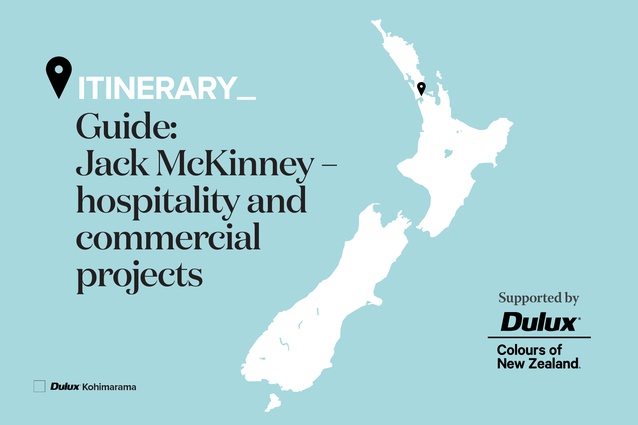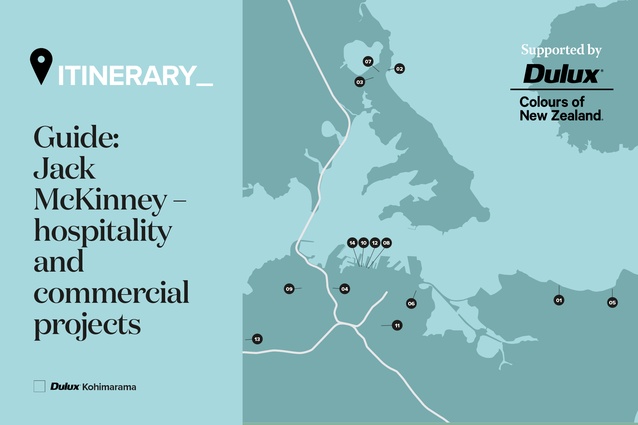Itinerary Guide: Jack McKinney — hospitality and commercial projects
In this Itinerary, supported by Dulux Colours of New Zealand, Andrew Barrie profiles architect Jack McKinney's hospitality and commercial projects in Auckland, where his work can be experienced first-hand.
Jack McKinney is possibly best known for sleek, high-end houses, having received Home magazine’s Home of the Year award in 2019 for Diagrid House and Here magazine’s inaugural nod for House of the Year in 2021 for Super Taper. These two projects epitomise the key streams in his domestic work: Niemeyeresque combinations of structural bravado and in-situ concrete, and studied compositions of natural light and sensual material.
This itinerary looks at McKinney’s commercial and hospitality work. Unlike the spare and spacious compositions that make his homes dramatic, these projects have to generate not just comfort but cash. They rely, therefore, on a different approach: one that can absorb the volume of people and stuff that must be crammed into a space to ensure not just firmness and delight but financial viability. The business of hospitality is volatile, the rule-of-thumb being that more than half of new restaurants close within a year of opening. Most of McKinney’s hospitality projects have changed hands – most likely thanks to the relentless lifestyle demanded of operators – but their ongoing success has made McKinney one of Auckland’s ‘go to’ designers for high-end hospitality.
The experience of such places is intensely curated – menus are meticulously researched and developed, supplies conscientiously sourced and ambience carefully tuned. In many cases, all is guided by strong philosophical and ethical positions. The architecture provides much of the choreography and, in McKinney’s work, seeks to tell much of the particular story. It’s a fine line to tread. The close proximity of two of McKinney’s fine dining interiors to the new food court in Commercial Bay reinforces the way in which, in even slightly less-skilled hands, this narrative approach can tip over into branding. McKinney often develops integrations and alignments that reduce the sense of clutter. Serveries morph into counters and tables, fittings become walls, arrays of chairs join into long banquettes and surfaces are created – fluted timber walls, ceilings of timber shutters or woven sticks – that absorb or disguise any disorder.
These projects span the range from good lunch spots to the ‘nice café’ in the neighbourhood to some of Auckland’s finest eateries. This top end is the architecture of the special occasion: spaces that don’t recede into the background but contribute to what is literally a full-body sensory experience. The taste and smell of the food, the chatter of dining companions, the glisten of wine in the hand and, even, the feel of the chair against one’s backside: each plays a role. This is design as the complete work of art: total architecture. Of course, it’s been the developed world living like it’s always a ‘special occasion’ that has brought the globe to its current perilous state.
McKinney is also one of our most sophisticated proponents of adaptive re-use. This includes working sensitively in some of our most important heritage buildings, where careful choices knit the new into the old, or where spaces are stripped back to reveal patina and character that is respectfully drawn into the ambience. Perhaps more importantly, he has demonstrated a particular ability with reshaping buildings of less-charming vintage; unpromising starting points are cleverly worked into satisfying new forms. Many of McKinney’s designs pick up on the ‘nose to tail’ and ‘locally sourced’ obsessions of their operators. This may be where architects have most to learn from restaurateurs and where McKinney’s work is most valuable to the profession; beginning work by carefully surveying what’s at hand and seeking to make the most of available resources may produce the most satisfying results.
THE ITINERARY
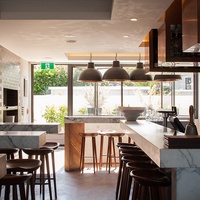
01. 2009, 2013 – The Bar and The Store on Kohi
3 Averill Avenue, Kohimarama
Just four metres wide but providing a range of settings, The Bar’s design employed a restrained palette of plush materials – stone, plaster, leather and timber – arranged in a spare composition. McKinney also designed The Store on Kohi next door. The Kohi businesses were the first ventures for Hip Group’s Jackie Grant and Scott Brown. The organisation would grow to include 12 sites across Auckland, employ nearly 500 people, and turn over $40m annually. McKinney designed many of its sites but the portfolio includes other stylish venues, such as the Cheshire Architects-designed Milse and Ortolana. The Bar and The Store have recently been demolished and the Hip Group restaurants have new owners.
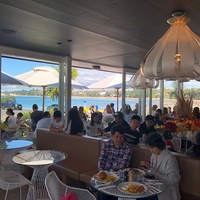
02. 2009 – Takapuna Beach Cafe
22 The Promenade, Takapuna
Another Hip Group project, this café occupies a prime spot in a beachside public reserve and is, unsurprisingly, a local favourite. With sweeping views down the beach and across the gulf to Rangitoto, the setting provides plenty of drama and the architecture doesn’t seek to compete. Externally, a large deck is tucked beneath umbrellas and a pōhutukawa, while the interior is a calm composition in painted timber, leather banquettes and tile that leaves all the emphasis on the view. Floor-to-ceiling sliding doors allow a seamless connection between the two zones when wind and weather allow.
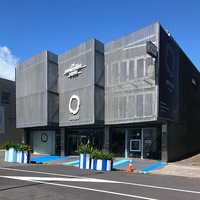
03. 2009 – The Department Store
10 Northcroft Street, Takapuna
A refit to a 1980’s Post Office building, this project’s key architectural feature is a projecting mesh screen that forms a staggered canopy over the sidewalk and balconies for the spaces above. Internally, this multi-storey department store was intended as a destination store designed to compete with the rise of internet shopping and included ‘highly curated’ boutiques for up-market art, design and fashion brands, such as Karen Walker and Simon James. Unfortunately, the internet eventually edged out this approach and the business closed in 2021, with the building now occupied by apartment developers Amaia.
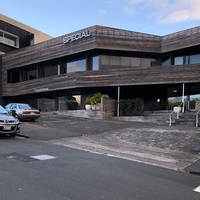
04. 2012 – Special Building
34–38 Drake Street, Freemans Bay
As at The Department Store, this project renovated an unremarkable commercial building by stretching a lightweight screen and balconies – in this case, timber – across its frontage. The façade’s clever geometry economically provides a generous approach, sheltered entry and outdoor space for the office staff. McKinney’s firm also designed the fit-out for software firm Propellerhead on the ground floor. It won a 2013 NZIA Auckland Architecture Award. Refer to Architecture NZ July/Aug 2013.
While visiting, note the building’s sophisticated neighbours – Architectus’ 32 Drake Street apartment building (2008) to the east and Marsh Cook’s rooftop apartment (2002) to the west.
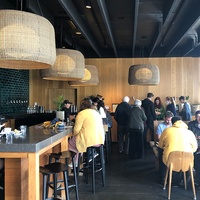
05. 2012 – St Heliers Bay Bistro
387 Tāmaki Drive, St Heliers
Nestled inside a sleek building (2012) designed by Kiwi-born but Sydney-based apartment maestro Ian Moore, this is another Hip Group project. The space is glazed on three sides, with views to the ocean on two sides and opening onto a sheltered courtyard on the third. Huge sliding doors allow a connection when the weather is right. The crisp geometry and cool grey of Moore’s raw concrete shell is softened with soft-toned linen, crafted oak furniture, oversized woven lampshades and glistening tiles. The project received an NZIA Auckland Architecture Award in 2013 and read a dedicated article on the bistro here. Refer to Interior Jun/Aug 2013.
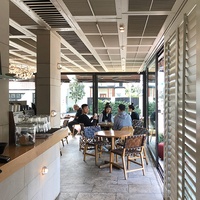
06. 2014 – Rosie
82 Gladstone Road, Parnell
Located in a neighbourhood dense with disposable income but with few places to eat, this spot has long been home to a busy café, and even the benches and stools on the footpath are often thronged with locals and visitors to the nearby Parnell Rose Gardens.
The tightly packed interior includes more beautiful timber and leather furniture, stone walls and a ceiling composed as a patchwork of painted timber shutters. The project received an NZIA Auckland Architecture Award in 2016. Refer to Urbis June/July 2014. Pop next door to Little Rosie, located in an early and now somewhat altered Fearon Hay building.
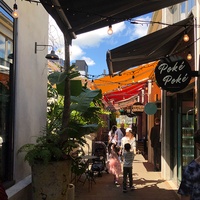
07. 2016 – Fortieth & Hurstmere
40 Hurstmere Road, Takapuna
Bestowing an NZIA New Zealand Architecture Award in 2016, the jury stated, “From nothing, the architect has produced a result that’s quite something. In a transformational exercise, an unprepossessing building has been excavated to yield a lively internal laneway lined with cafés and restaurants. The scale is sympathetic, the materials are well chosen and various, and the laneway spaces, including a small courtyard, work well. As much as anything, the project is a small essay in urban design, and it offers welcome depth and diversity to a shopping centre surrounded to the front and rear by cars.” Refer to Architecture NZ Nov/Dec 2016.
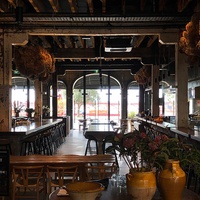
08. 2017 – Amano
68 Tyler Street, Central Auckland
Sited in the Britomart urban renewal project, this large restaurant occupies the ground floors of two heritage buildings. Within this cavernous space, the layout suggests an Italian market place, with a bakery on the Tyler Street frontage, an open kitchen dividing and enlivening the space, and the stripped-back surfaces of the heritage building creating a sense of intimacy. The last of the McKinney+Windeatt projects in this line-up, it won numerous awards, including the Supreme Award at the 2017 Interior Awards and an NZIA New Zealand Architecture Award in 2018. Refer to Interior Dec/Feb 2016/17 and June/Aug 2017.
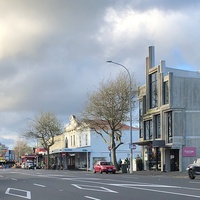
09. 2020 – Ponsonby Road
253 Ponsonby Road, Ponsonby
Using the in-situ concrete that has become a signature of McKinney’s domestic work, this project abstracts and twists the cornices and entablatures of Ponsonby Road’s character-defining historic buildings into a contemporary, ziggurat-like composition. Textured concrete also defines the interior, with the building now housing the New Zealand Institute of Architects’ head office, as well as McKinney’s own office. The project received an NZIA Auckland Architecture Award in 2021.
While you are there, zip across the road to Richard Toy’s 1956 masterpiece, All Saints Anglican Church, and pop some coins in the donation box for its restoration project.
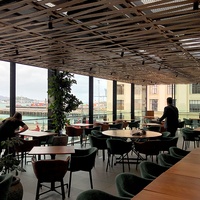
10. 2020 – Ahi
Level 2, Commercial Bay
172 Quay Sreet, Central Auckland
Located within the Commercial Bay development, this high-end restaurant is perched on an elevated corner overlooking the Ferry Building, the Old Post Office and the harbour.
Designed for high-flying chef Ben Bayly, its menu emphasises local produce. The fit-out, likewise, foregrounds locally sourced materials – including Corten steel, leather, salvaged timbers and ancient swamp kauri – and the products of New Zealand fabricators and designers, such as furniture designed by Simon James. The project received an NZIA Auckland Architecture Award in 2021 and a documentary on its development, available on ThreeNow, is well worth a look. Refer to Architecture NZ Nov/Dec 2020.
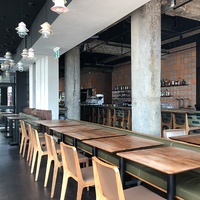
11. 2020 – Alma
130 Quay Street, Central Auckland
Located in a space that has housed a sequence of bars and cafés, this is another Hip Group venture, the offering here centring on the Andalusian cuisine of Southern Spain.
It is a long, narrow space, pressed against its Britomart frontage on three sides. The ambience has been tailored to the earthy vibe of the food: blown glass, surfaces of handcrafted tiles, the exposed concrete structure of the original 1930s’ building and an open fire at the centre of the space where the cooking is done. The project received an NZIA Auckland Architecture Award in 2022.
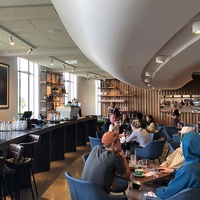
12. 2021 – Tuitui Museum Bistro and Café
Auckland Domain, Parnell
Inserted within the heritage shell of Tāmaki Paenga Hira Auckland War Memorial Museum as part of a wider refit of the southern atrium, the space is organised around a super-long, curved marble counter. Employing perhaps the most pared-back colour and textures of McKinney’s restaurants, here, fluted surfaces riff on the classical forms of the Museum. The project received an NZIA National Architecture Award in 2021. Be sure to explore the Te Ao Mārama refurbishment project by Jasmax, FJMT and designTRIBE, as well as the T. Rex skeleton in the atrium. Refer to Architecture NZ May/June 2021.
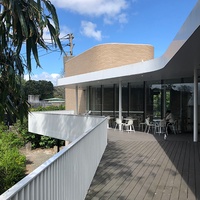
13. 2021 – Te Puna at Auckland Zoo
Designed in collaboration with Stevens Lawson Architects – McKinney and Gary Lawson were co-workers during their time at Pattersons – this project stands at a crossroads within the lush grounds of the Zoo. The design is a sinuous composition in which diners enjoy a glassy, low-slung dining room and verandahs, with service and back-of-house spaces enclosed within tall pods of brick. The project received a 2021 NZIA Auckland Architecture Award. Enjoy the Zoo’s growing collection of interesting buildings, including the Giraffe House (2013) by Monk Mackenzie and Glamuzina Paterson, and the Administration Building (2018) by Ignite Architects.
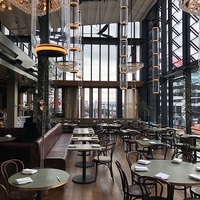
13. 2022 – Origine
Level 2, Commercial Bay
172 Quay Street, Central Auckland
Opened just weeks ago, this bistro is located a few steps from Ahi and involves some of the same personnel. Its French-inspired cuisine and the French theme is expressed in the space through glass bricks (think Maison de Verre), Thonet bentwood furniture and French oak floors. The space itself is dramatic, with huge, glass light fittings making the most of its massively high ceiling, such that food critic Jesse Mulligan wrote of it, “The ultimate New Zealand compliment – ‘it feels like you’re not in Auckland’ – really applies when you first walk in.”
Other addresses
Kiwi Bacon (2007) — 317 New North Road, Kingsland
(This was a partial refurbishment of an iconic industrial building, the most visible aspect of which was the diagrid-framed external lift shaft).
Mount Eden Steel Works (2009) — Coles Avenue, Mount Eden
Waihi Beach Hotel Eatery & Store (2014) — 60 Wilson Road, Waihi Beach
Servilles City Works (2020) — 18 Sale Street, Central Auckland
Biography
Jack McKinney spent his early years in the famous but tiny West Coast mining town of Blackball (pop. 300), living on the road between town and the local rubbish dump. He moved to Dunedin for high school, before heading north to study architecture at the University of Auckland. On graduation, McKinney worked for nearly four years at what was then Patterson Co-Partners Architects, alongside Gary Lawson (with whom he worked on Site 3 and Cumulus) and Bryan Windeatt, 15 years his senior. Having received the Resene Travel Award as a graduate, he spent a year travelling in Europe and the United States. Returning to New Zealand, he formed McKinney+Windeatt with his fellow Patterson alum in 2002. The firm dissolved in 2018, and he practises now as Jack McKinney Architects.

The itinerary series is supported by Dulux Colours of New Zealand. Dulux Colour Specialist Davina Harper has selected a Colours of New Zealand palette based on this itinerary. See the full range and order colour samples here.

